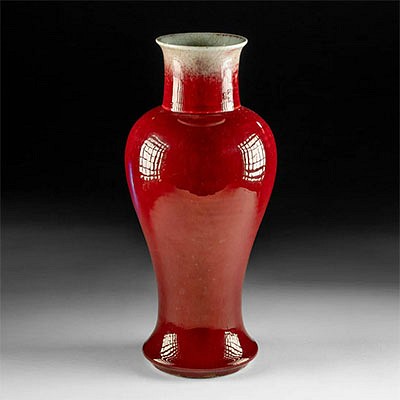18th C. Burmese Karen Leaded Bronze Rain Drum
Lot 171
About Seller
Artemis Gallery
686 S Taylor Ave, Ste 106
Louisville, CO 80027
United States
Selling antiquities, ancient and ethnographic art online since 1993, Artemis Gallery specializes in Classical Antiquities (Egyptian, Greek, Roman, Near Eastern), Asian, Pre-Columbian, African / Tribal / Oceanographic art. Our extensive inventory includes pottery, stone, metal, wood, glass and textil...Read more
Categories
Estimate:
$2,400 - $3,600
Absentee vs Live bid
Two ways to bid:
- Leave a max absentee bid and the platform will bid on your behalf up to your maximum bid during the live auction.
- Bid live during the auction and your bids will be submitted real-time to the auctioneer.
Bid Increments
| Price | Bid Increment |
|---|---|
| $0 | $25 |
| $300 | $50 |
| $1,000 | $100 |
| $2,000 | $250 |
| $5,000 | $500 |
| $10,000 | $1,000 |
| $20,000 | $2,500 |
| $50,000 | $5,000 |
| $100,000 | $10,000 |
| $200,000 | $20,000 |
About Auction
By Artemis Gallery
May 11, 2023
Set Reminder
2023-05-11 10:00:00
2023-05-11 10:00:00
America/New_York
Bidsquare
Bidsquare : Fine Antiquities, Asian, Pre-Columbian, Ethnographic Art
https://www.bidsquare.com/auctions/artemis-gallery/fine-antiquities-asian-pre-columbian-ethnographic-art-12771
Classical antiquities, ancient and ethnographic art from cultures encompassing the globe. Artemis Gallery info@artemisgallery.com
Classical antiquities, ancient and ethnographic art from cultures encompassing the globe. Artemis Gallery info@artemisgallery.com
- Lot Description
**Originally Listed At $1200**
Southeast Asia, Myanmar and Thailand, Karen people, ca. 18th to 19th century CE. A stunning and quite impressive leaded bronze rain or frog drum, created by the Karen - a Sino-Tibetan ethnic group inhabiting the highlands between Myanmar and Thailand - elaborately adorned with dense relief decoration and rich iconography. The outstanding instrument features a circular tympanum engraved with an 8-pointed star surrounded by registers of stylized fish, birds, and geometric motifs, as well as 4 sets of 3 stacked frog figures, equally placed around the periphery. Additional registers of geometric designs encircle the concave drum body with a pair of handles protruding from each side and a procession of 3 snails - representing rain - and 3 elephants - symbolizing wealth - march down the vertical seam. Size: 24.4" Diameter x 18.1" H (62 cm x 46 cm)
Drums like this example have been used in Southeast Asian cultural rituals for hundreds of years. Such bronze drum forms originated with the Bronze Age Dong Son culture of ancient northern Vietnam during the later period of the Hong Bang Dynasty. The Karen people have continued to use these drums into the present day and may have thus preserved the ancient cultural practices of the Dong Son. The drums serve many functions, not least in instilling fear in an enemy and during celebrations after a victory in war. Reverberating in the hills, the pleasing tones emanating from the drums were believed to placate Nat spirits residing in trees, streams, rocks and other objects in the natural environment, thus ensuring these spirits would look kindly on the Karen and help them in times of need. The drums were also beaten to invite ancestor spirits to partake in feasts as well as to witness crucial ceremonies such as weddings and funerals. It was important to conciliate ancestor spirits as they could intercede with Nat spirits on behalf of the Karen. The drums were additionally associated with rain as they were often played in accompaniment with a ritual dance to summon rain. It was thought that the low-frequency pitch from the drum induced frogs to croak and that croaking frogs are a harbinger of rain. Thus, the 3-dimensional frogs embedded on the tympanum are an indication of the instrument's usage.
The Karen also believed that a spirit resided within the drum and at times it was thought beneficial to propitiate it with small bowls of liquor and rice. Failure to do so might result in the early death of the owner. Any changes to the surface of the drum were carefully noted and thought to be indications of the spirit's well-being and intentions. For example, condensation on the surface was not regarded as a good omen; it was interpreted as weeping and if nothing was done, sickness and death could result. To avert such a calamity, a ritual was performed with the blood of a chicken to appease the spirit of the drum.
Cf. Metropolitan Museum of Art, 89.4.1234.
Provenance: private Arlington, Texas, USA collection, acquired mid to late-1960s
All items legal to buy/sell under U.S. Statute covering cultural patrimony Code 2600, CHAPTER 14, and are guaranteed to be as described or your money back.
A Certificate of Authenticity will accompany all winning bids.
We ship worldwide and handle all shipping in-house for your convenience.
#178097A few small perforations to walls of drum body with some stable hairline fissures and repairs. Expected nicks and abrasions to surface, all commensurate with age. Otherwise, excellent with nice remaining decoration. Rich patina throughout.Condition
- Shipping Info
-
All shipping is handled in-house for your convenience. Your invoice from Artemis Gallery will include shipping calculation instructions. If in doubt, please inquire BEFORE bidding for estimated shipping costs for individual items. In most cases Artemis Gallery cannot ship to Australia and Germany, please inquire before bidding.
-
- Buyer's Premium



 EUR
EUR CAD
CAD AUD
AUD GBP
GBP MXN
MXN HKD
HKD CNY
CNY MYR
MYR SEK
SEK SGD
SGD CHF
CHF THB
THB














